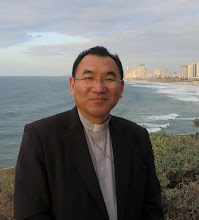National meeting of diocesan directors for relief and rehabilitation activities on the Great East Japan Earthquake (2011) met in Koriyama Catholic Church, Fukushima prefecture, from Tuesday 24 June to Thursday 26. More than 70 people attended the meeting. Participants were either diocesan directors appointed by respective bishops in charge of relief and rehabilitation activities in disaster hit area in Sendai diocese (Iwate, Miyagi and Fukushima) or their collaborators. Each of 3 ecclesiastical provinces have their own base of activities within Sendai diocese under the coordination of Sendai Diocese Support Center and Bishops' Conference Support team for which I am in charge. (Photo above: waiting for an opening session in Koriyama Catholic Church in Fukushima prefecture)
The participants were divided into three groups for area visits, one for Iwate, the other for northern Fukushima and the last one for southern Fukushima. Entire group met on Wednesday evening in Koriyama. I joined the third group which went around southern Fukushima for two days.
First day of the group 3. We visited Shirakawa city, southern end of Fukushima, to meet with a local counseling group led by Catholics to visit temporary housings for evacuees from Nuclear Power Plant accidents. We also went to Iwaki to meet with evacuees of Tsunami who are preparing to move into government provided new housings from temporary residence. (Photo above: Ms.Kanazawa, a leader of the house visit and counseling group, "MIMIZUKU" of Shirakawa city sharing her experience)
On the second day, we visited town of Naraha and Tomioka quite close to the Fukushima Daiichi (NO.1) nuclear power plant. We could pass by the Fukushima Daini (NO.2) nuclear power plant and approached to the Daiichi. Then the road was blocked by police barrier in Tomioka. The local government of Naraha are preparing to return to the original community but even the officials of the town were not so sure how many people would actually come back. Then Naraha town which is closer to the Daiichi power plant has been divided for the area for which residents are able to return and the area for which residents are unable to return. Inside the town, we could see one side of the road is restricted and the other not. Community are divided. People are divided. (Photo above: Officers of the Naraha town office showing the participants of the group three how to measure radiation)
On Thursday morning, we met in Koriyama Catholic Church to listen to stories of 8 people working in Fukushima prefecture for evacuees. There were so many different stories. Even though the rehabilitation program moves very slow, those in Iwate and Miyagi have, at least, some hope for future. But those in Fukushima, especially those near to the nuclear power plant have difficulty to find hope for future. Already some decided not to return. What would be happen to these local communities which are already losing their residents because of aging society. (Photo above: JR Tomioka Station after 3 years of Tsunami. Becasue of radiation, residents are not allowed to return and, thus, the station and town hit by tsunami remains the same)
The meeting ended with Mass by Bishop Hiraga of Sendai at Koriyama catholic church on Thursday afternoon. Since then I have moved to Akita to stay with members of the Seitai Hoshikai till Sunday.(Photo above: Inside the town of Tomioka. In front, there are barrier to prevent anyone to enter. Right hand side is the area to which residents are not allowed to return. Left hand side, residents are expected to return in near future.)
Through the meeting in Koriyama we leaned a lot about complex situation in Fukushima. Japanese Bishops are against nuclear power plants in Japan. At the same time, Bishops are calling to change present life style in Japan which consumes a lot of energy. Of course, Bishops do know that we can not force Catholics to have same opinion over this issue with us. We know there are different opinion within Church itself. We know there are voices against return to Fukishima because of radiation. We also know there are voices assuring safety of Fukushima. But what we can say is that ordinary people's ordinary life was destroyed in many ways and into many directions because there had been nuclear power plants in Fukushima. As we see the reality of people in Fukushima, we are not able to keep our mouth shut. So much issues in different levels have been mixed together to be the cause of difficulties for people's everyday life and that makes objective discussion almost impossible.
In any case, the point is quite clear. Come and see the reality of people. People are deprived of their ordinary life. It is quite a challenge for most of them to claim them back. Majority in the society do not care anymore of the difficulties which people in Fukushima face everyday in order to maintain their daily life. Even though they are not responsible to what has been happened in Fukushima, people have to take responsibility to make choices of their life. This is not the issue contained within the boundary of Fukushima prefecture. It is the issue for entire Japan and we should not forget daily sufferings of people in Fukushima. Communities are divided. families are divided. Firends are separated. All for what reason? (Radiation meter in front of Futaba town temporal police station.)








No comments:
Post a Comment